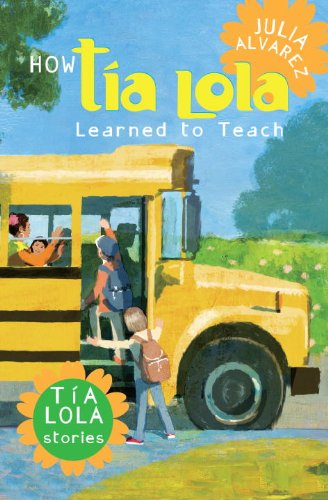Alvarez, Julia
11 Reviews
(3)
K-3
Illustrated by
Sabra Field.
For children grappling with their emotions surrounding death, poetic questions and responses have a quietly reassuring tone as the unnamed narrator speaks of possibilities, not answers: "I catch just a glance / in the hills' quiet stillness, in a storm's dark advance." Elegant woodcuts show a diverse group of children and use serene landscapes, white silhouettes, cloud formations, etc., as palpable but open-ended visual references to the dead.
Reviewer: Melinda Greenblatt
(2)
4-6
Victor Espada and his three daughters stay for a week with Miguel, his sister Juanita, Mami, and Tía Lola. Victor, who helped Tía Lola with immigration problems, has become more than just a friend to Mami. Children of divorce will be inspired by this loving and respectful new family configuration, and they'll wish they had a Tía Lola to shepherd the process.
Reviewer: Robin L. Smith
| Horn Book Magazine Issue:
May, 2011
(3)
4-6
Tía Lola and company decide to turn Colonel Charlebois's Vermont house into a bed-and-breakfast. Once they've opened their doors, it quickly becomes clear that someone doesn't want the new business to be successful, so the children set out to solve the mystery. The final chapter wraps the upbeat series into a neat bow.
Reviewer: Robin L. Smith
(2)
4-6
In this warm-hearted sequel to How Tía Lola Came to Visit Stay, Miguel and Juanita are adjusting to life in small-town Vermont without their father. Meanwhile, the principal asks Tía Lola to teach Spanish at school. With easy-to-understand Spanish phrases sprinkled throughout the text and Dominican adages heading each chapter, Alvarez invites everybody into this welcoming family and community.
Reviewer: Robin L. Smith
| Horn Book Magazine Issue:
January, 2011
(3)
4-6
After an accident injures Tyler's father, their farm is in danger of folding--until a family of Mexican immigrants (some illegal) comes to help. Tyler befriends Mari, the oldest daughter, and helps the family reunite with Mari's mother, to whom Mari writes heartfelt letters. The various relationships are complicated and nuanced, and the issues Alvarez raises will give readers pause.
Reviewer: Elissa Gershowitz
(1)
YA
Translated by Liliana Valenzuela.
In this translated edition of Before We Were Free (Horn Book rev. 9/02), the first-person present-tense narration flows as naturally as if Spanish had been the original language. This edition of Alvarez's Pura Belpré award winner is an essential title for bilingual collections and for libraries serving Spanish-speaking communities.
Reviewer: Tim Wadham
(4)
YA
Milly enjoys being considered "100 percent American" and rarely speaks of her foreign birth and adoption. When Pablo arrives from the (unnamed) Central American country of Milly's birth, she decides to travel with his family to recover her lost identity. While the secrecy surrounding Milly's adoption seems anachronistic, the emotional drama and touch of romance will appeal to teen readers.
Reviewer: Lauren Adams
(3)
K-3
Translated by Dolores Prida.
Illustrated by
Fabian Negrin.
This is a Spanish edition of Alvarez's The Secret Footprints, a retelling based on a Dominican folktale about a tribe of people whose feet point backward so as not to reveal their location. The translation is nicely done, and the language provides a real sense of the storytelling tradition. The vibrantly colored illustrations give the tale both a sense of place and a dreamlike quality.
Reviewer: Tim Wadham
(1)
YA
This book bridges Alvarez's two adult novels set during the final days of the Trujillo dictatorship in the Dominican Republic. In the fall of 1960, Anita, almost twelve, tries to gain some control over frightening events by writing in her diary. Her final months in the country are a poignant blend of typical adolescent concerns and the terrible realities of life under a violent dictatorship. This is a compelling acount of a girl growing up too quickly while coming to terms with the cost of freedom.
Reviewer: Lauren Adams
| Horn Book Magazine Issue:
September, 2002
(3)
4-6
When Miguel's Spanish-speaking Dominican aunt comes to visit his newly divorced mother in their new home in Vermont, her colorful ways at first embarrass him, then eventually endear her to him. What the story lacks in a clear central conflict, it makes up for with vivid characterization and evocative imagery. Dominican Spanish words flavor the narrative like so many of TÃa Lola's spices.
Reviewer: Erica L. Stahler
(3)
K-3
Illustrated by
Fabian Negrin.
Based on Dominican folklore, this dreamy story tells how a bold ciguapa almost reveals her tribe's whereabouts. Ciguapas are beautiful creatures who live underwater and hunt for food on land at night; their feet are on backwards, so their footprints never give their location away. Illustrations in a rich blue-green palette bring out the magical realism in this well-told tale.
Reviewer: Pamela McCuen
11 reviews
We are currently offering this content for free. Sign up now to activate your personal profile, where you can save articles for future viewing.















